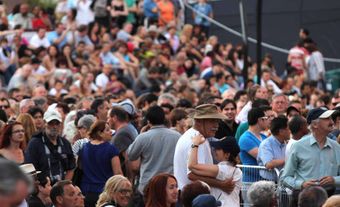Laval, Que
Laval, Que. City to the north of Montreal bounded by l'île Jésus. Until 1854 the tilling of the soil was done within the framework of the seigneurial system. The fertility of the soil turned the habitants towards agriculture, but at the beginning of the 20th century the appearance of l'île Jésus changed and summer visitors discovered the banks of the river which encircle the island. After WW II industries were established as new beidges made the island more accessible. In 1965 the 14 municipalities of the island joined together to form Laval. In 1991 the city had a population of about 300,000 people; it was the second most important city in Quebec in terms of area and population.
From 1965 the city took a leap forward economically, demographically and culturally, but it was particularly in the 1980s that numerous cultural organizations were establishedstarted up. In 1991 there were more than a dozen orchestras, choirs, opera studios and bands, performing either in the André-Mathieu auditorium at the Montmorency Cegep (inaugurated in 1978), at the Laval Arts Centre (inaugurated in 1986) or in various churches and amphitheatres in the area. Outdoor concerts were also given at the Nature Centre. In the realm of organ manufacture, Laval has acquired a certain reputation thanks to Hellmuth Wolff, who established himself in Laval in 1968.
The Laval Symphony Orchestra, established in 1984 under the name of the Philharmonie de Laval, and renamed the following year, was conducted by Gilbert Patenaude until 1987, then by Marc Fortier (1987-88) and Paul André Boivin (1988-). The inaugural concert, in November of 1985, was an outstanding success. The number of annual concerts (three in the first season), has grown ever since. In 1987 the orchestra was invited by the Arts Council of the City of Montreal to inaugurate the festivities for the 20th anniversary of Terre des Hommes. In 1991 the orchestra commissioned two works: Suite concertante Sayat Nova by Petros Shoujounian and Sinfonirik by Anthony Rozankovic. Among the invited soloists, have been Claudine Côté, Hélène Fortin, Bruno Laplante, Marc-André Hamelin, Sophie Rolland and Marie-Josée Simard. The Chamber Orchestra of the Laval Symphony Orchestra, comprising around twenty musicians, was created in 1989.
Les Petits chanteurs de Laval was established in 1981 by Julien Belzil, and conducted by Rolland Counoyer (1983-87), succeeded by Gregory Charles (1987-). This choir, made up exclusively of male voices (50 children and 15 adults), has performed in the USA, Belgium, France, Switzerland, Quebec, and Ontario. It has sung with the Laval SO and the Théâtre d'art lyrique de Laval. It took part in the recording of a CD Negro Gospel Happenings in 1989 (nos 5 to 10, Amplitude JACD-4015).
The Choeur de Laval was established in 1968 by its director Germain Lefebvre. It has been conducted by Franz-Paul Decker, Otto-Werner Mueller, Miklos Takacs, Janus Cziffra, Paul André Boivin and Jacques Lacombe. It has performed at the Festival international de Lanaudière, at the PDA (in particular Verdi's Nabucco in 1990) and in various churches in the region. In 1988 it toured France, Austria and Italy. In 1979 it recorded the Sept paroles du Christ by Dubois with organist Yves Godbout, soprano Louise Le Cavelier, tenor Paul Trépanier and bass Roland Gosselin (SNE 504).
The Harmonie de Laval was created in 1980 by Pierre Gosteau, who conducted it until 1982. Subsequent conductors were Jean-Yves Hardy (1983), Alain Cazes (1984-90), and André Moisan (1990 -). Made up of about forty musicans, the Harmonie has also started a music camp and a promotion agency.
The Théâtre d'art lyrique de Laval was established in 1981 by Céline Bigras-Brousseau, Roger Lessard, Jacques Poissant, Jean-Louis Tremblay and Nicole Pontbriand-Beaudoin. Jean-Paul Desjardins was its first musical director; Gilbert Patenaude succeeded him in 1986. The aims of the theatre are to offer singers, actors, musicians, directors, choreographers and costume makers the possibility of uniting all their talents to produce excellent shows; to give the Laval public the opportunity of attending performances of operetta and opera without having to leave the city; and finally, to provide the young aiming for a professional career with stage experience, directed by a professional team. The repertoire is divided between operetta (Offenbach's La Vie parisienne, Lehar's The Merry Widow and opera (Bizet's Carmen). In 1987 the Théâtre presented two Canadian operas: Colas et Colinette by Joseph Quesnel and Silent Measures by Maurice Blackburn. The company has performed on several occasions throughout Quebec. In 1989 it gave the European premiere of Patenaude's opera Pour ces quelques arpents de neige in France and Belgium, having first introduced it in Laval.
Music education has held an important place in the Laval region. As of 1991 two schools, Alpha School and Cedar School, offered music concentration. Several of the young musicians between the ages of 11 and 16 have joined together to form the Symphonie des Mille-Îles. This instrumental group, established in 1987 by its conductor Gilbert Patenaude, is part of the special projects of the Mille-Îles School Board. Patenaude has also conducted a choir for girls aged 9 to 16 years, L'Art qui chante au féminin, since its founding in 1988. In addition to learning voice production, these girls are introduced to solfège. In 1991 the choir performed Vladimir Kojoukharov's opera Le Paradis des chats.
Laval is well known for its drum and bugle bands. The Châtelains et Châtelaines de Laval have won many championships, including the girls' section of the world championship of drum and bugle bands in Denver, Colorado, in 1978. The same section also won the international championships which were held in Montreal in 1981 and 1982.
Among the musicians native to Laval,are Paul André Boivin, Charles-François Coron, Joseph Lajeuness, Germaine Malépart and Edmond McMahon.

 Share on Facebook
Share on Facebook Share on X
Share on X Share by Email
Share by Email Share on Google Classroom
Share on Google Classroom

